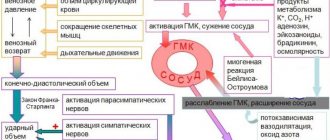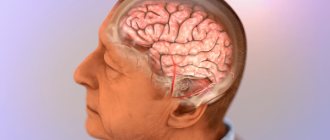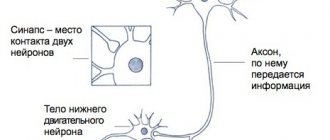ADHD in adults: what it is, symptoms, diagnosis, treatment
By: Administrator |
Tags: Diagnosis of ADHD, Treatment of ADHD, Causes of ADHD, ADHD, Attention Deficit Hyperactivity Disorder | Comments: | July 21, 2021 Attention deficit hyperactivity disorder (ADHD) is a condition that affects concentration, memory, and behavior. It was once thought that children with the condition outgrew the condition, but it is now recognized that many remain affected for life.
According to statistics, this disorder affects approximately one in 20 adults, mostly men. The disease is usually diagnosed in childhood, but some people are undiagnosed. It is much more difficult for able-bodied people to overcome the disorder as it makes managing daily activities more difficult, especially tasks that require organization, planning and focus. Among other things, many begin to drink, smoke and use psychotropic substances.
Features of ADHD in adults
Lack of focus and concentration is a neurological condition. Brain scanning studies show that people with this condition have neural circuits that are slightly different than those of normal people. Physical and chemical differences in the brain affect executive functioning. This means that people with ADHD have a much harder time concentrating and regulating their behavior.
The main features are:
- Difficulty staying interested (for example, at work during conversations or personal relationships);
- hyperactivity (for example, fidgeting or inability to sit still, talk a lot, gesticulate excessively);
- Impulsivity (eg, interrupting conversations, inability to wait in line).
What causes ADHD?
The formation of ADHD is based on neurobiological factors: genetic mechanisms and perinatal damage to the central nervous system (damage to the brain and spinal cord that occurs during pregnancy, childbirth and the early postpartum period), which can be combined with each other. It is they who determine changes in the functioning of the nervous system and disorders of higher mental functions and behavior that correspond to the picture of the syndrome.
In many cases, additional influence on children with ADHD is exerted by negative socio-psychological factors (primarily intra-family), which in themselves do not cause the development of ADHD, but always contribute to an increase in the child’s symptoms and adaptation difficulties.
Disorders associated with ADHD (so-called comorbid disorders).
Additional difficulties in family, school and social adaptation in children with ADHD may be associated with the formation of concomitant disorders that develop against the background of ADHD as the underlying disease in at least 70% of patients. Comorbid disorders in ADHD are represented by the following groups: oppositional defiant behavior, anxiety disorders, mood disorders, speech development disorders, learning difficulties, lack of coordination, awkwardness, tics). Other related ADHD disorders may include sleep disturbances and involuntary urination during sleep.
Causes of the disorder
ADHD is not caused by poor parenting, too much sugar, additives, absent fathers, or vaccines. These are all myths. Most often, attention deficit disorder is a genetic disease. The chance that a child will inherit the disease from one parent who has a genetic predisposition is 70–80%.
But there are a number of other factors that contribute to the development of pathology:
- traumatic brain injury or infection;
- lack of oxygen or exposure to alcohol or nicotine before birth;
- premature birth;
- difficult experiences in early childhood.
Diagnosis of hyperactivity
Children suspected of having ADHD are under the constant supervision of their attending pediatrician. In this case, a neurological diagnosis is not established earlier than 5-7 years. This is due to the developmental characteristics of preschool children. Child psychologists try to diagnose only after the completion of the transitional age crises of 3 and 7 years.
Diagnosis is carried out by a child psychologist together with a neurologist and pediatrician. Consultation with several specialists makes it possible to exclude other diagnoses that lead to increased activity and excitability. Also, during diagnosis, doctors reassure parents that their baby’s increased excitability, restlessness, is only a manifestation of character.
The baby’s condition is monitored from the first weeks of life. If hyperactivity is suspected, the doctor conducts a thorough analysis of the child’s behavior in everyday life.
Diagnostics includes three stages:
- a conversation between a child psychologist and the child’s parents;
- researching;
- obtaining advice from the pediatrician treating the baby.
To confirm the diagnosis in a hospital setting, EEG, REG, M-Echo, MRI are performed. Before conducting research, it is recommended to keep your child busy with an interesting game. You can give a mild sedative.
How to Identify ADHD Symptoms in Adults
The key symptoms of this disease are inattention, hyperactivity, and impulsivity, but this is a very limited list. It is worth considering in detail how the symptoms of the diagnosis manifest themselves.
Examples of inattention symptoms:
- inability to concentrate on a task for long periods of time;
- disorganization (for example, not being able to regularly use diaries or calendars);
- constant forgetfulness (of things that happened this afternoon, etc.);
- easy distractibility of a person and his inability to return to the previous task;
- delay in completing tasks and constant disorganization;
- excessive clumsiness;
- falling asleep in class or meetings;
- poor time management.
Some people with ADHD can control themselves and focus when they really enjoy something. But loss of concentration also occurs when they become bored. In this case, hyperactivity manifests itself, which is difficult to control.
Examples of symptoms of hyperactivity:
- the patient seems excited or nervous all the time - at work this can manifest itself on any day: both on the day of submitting a report to the manager, and on the most ordinary day or during a corporate party;
- being unable to sit still and concentrate - thoughts scatter and a person takes on many tasks without completing them;
- talk without interruption, without noticing others;
- having a fast flow of thoughts or being unable to stop thinking is one of the subtle symptoms;
- constant problems with sleep.
It is also worth mentioning a separate symptom of the diagnosis of ADHD in adults - excessive impulsiveness:
- a person does not take into account the consequences of his actions;
- constantly interrupts other people;
- takes over what someone else does;
- changes jobs frequently;
- uses drugs and alcohol in large doses;
- too hot-tempered and irritable.
Main manifestations
The International Classification of Diseases has an entire section dedicated to ADHD. Diagnoses vary in the presence and prevalence of symptoms of the pathology, but for the most part they concern children, since most of these manifestations disappear as they grow older. First of all, this concerns hyperactivity.
It rarely occurs in adults. This is explained by the fact that the human body changes completely after puberty, and its energy resource becomes limited. But at the same time, after adulthood, new symptoms of ADHD arise. Among them, instability of attention is most clearly manifested. Such people find it very difficult to carry out daily tasks, such as cleaning the house, preparing food, sorting things and putting them in their places.
People with ADHD tend to provoke conflict. Constant quarrels cause family destruction. You can determine that an adult has ADHD by the following signs:
- Difficulty performing routine tasks such as cleaning or cooking. In everyday life, such people are disorganized, they are absent-minded, easily distracted by extraneous matters and are constantly late;
- inability to draw up and control your own budget, as well as pay utility and other bills on time. People with ADHD do not know how to save money and use it wisely;
- lack of ability to listen to the interlocutor to the end;
- lack of tact when communicating with other people. It is difficult for a person with this type of disorder to restrain spontaneous statements; they are extremely impulsive;
- forgetfulness, which manifests itself in the inability to take medications regularly;
- lack of interests and hobbies. Attention deficit disorder in adults is manifested in the inability to concentrate at work and engage in one type of activity for a long time;
- Constant difficulties arise when planning your activities, as well as in the subsequent implementation of your plans. Patients with attention deficit disorder almost always lack long-term plans;
- inability to make a report, draw a conclusion, or draw a conclusion. Inability to analyze anything.
All these manifestations of the disease negatively affect a person’s work. The inability to concentrate on performing work duties and important assignments does not allow you to move up the career ladder and reach heights in the profession. Intemperance and impulsiveness, as well as a lack of tact, complicate relationships with colleagues and superiors. For the same reason, conflicts may arise in the family with loved ones.
With ADHD, difficulties may arise with driving a car, since such people cannot concentrate their attention on the road, notice all road users, road signs, compare pictures from the mirrors, assess the situation and carry out the necessary actions at that moment.
The syndrome also affects the intimate sphere, especially for women. It is almost impossible for them to achieve orgasm with this disorder. During sexual intercourse, you need to fully concentrate on what is happening and your feelings, and ADHD does not allow you to do this.
It is incredibly difficult for an adult with ADHD to read books and watch movies, especially if the plot is not captivating from the first words or seconds. Such people simply do not have enough patience; they lose interest in history after just a few minutes.
Methods for diagnosing ADHD
The diagnosis must be made by a mental health professional with treatment experience, but additional testing is also necessary, including:
- consultations with a psychotherapist and psychiatrist;
- electroencephalography (EEG);
- brain scan (MRI);
- Ultrasound Dopplerography of blood vessels (USDG).
Typically, adults are only diagnosed with this if there is evidence that they had symptoms in childhood. The symptoms must also be present in more than one situation (for example, at work and at home) and affect daily life. The presence of at least 5 symptoms within six months is indicative. If you find such a number of symptoms, you should definitely consult a doctor.
Causes of ADHD
A reliable and unique cause of the syndrome has not yet been found; the disorder is polyetiological, i.e. combines several harmful factors. It is believed that the formation of ADHD is based on neurobiological factors: genetic mechanisms and early organic damage to the central nervous system, which can be combined with each other. They are the ones who determine changes in the central nervous system, disorders of higher mental functions and behavior that correspond to the picture of ADHD. In many cases, additional influence on children with ADHD is exerted by negative socio-psychological factors (primarily intra-family), which in themselves do not cause the development of ADHD, but always contribute to an increase in the child’s symptoms and adaptation difficulties.
Genetic mechanisms. The genes that determine predisposition to the development of ADHD include genes that regulate the exchange of neurotransmitters in the brain, in particular dopamine and norepinephrine. ADHD is considered a polygenic disorder, in which multiple simultaneous disturbances in the processes of dopamine and/or norepinephrine metabolism are caused by the influence of several genes, overriding the protective effect of compensatory mechanisms.
Pre- and perinatal factors play an important role in the pathogenesis of ADHD. The formation of ADHD may be preceded by disturbances during pregnancy and childbirth, in particular gestosis, eclampsia, first pregnancy, maternal age younger than 20 years or older than 40 years, prolonged labor, post-term pregnancy and prematurity, low birth weight, morphofunctional immaturity, hypoxic -ischemic encephalopathy, a disease of a child in the first year of life. Other risk factors include maternal use of certain medications during pregnancy, alcohol, and smoking.
The neuropsychological mechanisms of ADHD are considered from the standpoint of dysfunction (immaturity) of the functions of the frontal lobes of the brain, primarily the prefrontal region. Manifestations of ADHD are analyzed from the perspective of deficits in the functions of the frontal and prefrontal parts of the brain and insufficient development of executive functions (EF). ADHD patients exhibit "executive dysfunction." The development of EF and the maturation of the prefrontal region of the brain are long-term processes. Significant components of EF that are affected in ADHD are: impulse control, behavioral inhibition (containment); organization, planning, management of mental processes; maintaining attention, keeping away from distractions; inner speech; working (RAM) memory; foresight, forecasting, looking into the future; retrospective assessment of past events, mistakes made; change, flexibility, ability to switch and revise plans; choice of priorities, ability to manage time; separating emotions from real facts.
The influence of unfavorable environmental factors. Pollution of the natural environment, largely associated with microelements from the group of heavy metals, can have negative consequences for the health of children. It is known that in the immediate vicinity of many industrial enterprises, zones with high levels of lead, arsenic, mercury, cadmium, nickel and other trace elements are formed. The most common neurotoxicant from the group of heavy metals is lead, and its sources of environmental pollution are industrial emissions and vehicle exhaust gases. Lead exposure to children can cause cognitive and behavioral disorders in children.
The role of nutritional factors and unbalanced nutrition. The emergence or intensification of ADHD symptoms can be facilitated by an imbalanced diet (for example, insufficient protein with an increase in the amount of easily digestible carbohydrates, especially in the morning), as well as a lack of micronutrients in food, including vitamins, folates, omega-3 polyunsaturated fatty acids (PUFAs) , macro- and microelements. Micronutrients such as magnesium, pyridoxine and some others directly affect the synthesis and degradation of monoamine neurotransmitters. Therefore, micronutrient deficiencies may influence neurotransmitter balance and, consequently, the manifestation of ADHD symptoms.
Thus, ADHD is a complex neuropsychiatric disorder, accompanied by structural, metabolic, neurochemical, neurophysiological changes in the central nervous system, as well as neuropsychological disorders in information processing and EF.
ADHD symptoms in children
Symptoms of ADHD in a child may be the reason for an initial visit to pediatricians, speech therapists, speech pathologists, and psychologists. Often, the symptoms of ADHD are first noticed by teachers in preschool and school educational institutions, and not by parents. Detection of such symptoms is a reason to show the child to a neurologist and neuropsychologist.
Main manifestations of ADHD
1. Attention disorders
Does not pay attention to details and makes many mistakes. Has difficulty maintaining attention when completing school and other tasks. Does not listen to speech addressed to him. Cannot follow instructions and complete a task. Unable to independently plan and organize tasks. Avoids activities that require prolonged mental stress. Often loses his things. Easily distracted. Shows forgetfulness.
2a. Hyperactivity
Often makes restless movements with his arms and legs, fidgets in place. Cannot sit still when needed. Often runs around or climbs somewhere when it is inappropriate. Can't play quietly and calmly. Excessive aimless motor activity is persistent and is not affected by the rules and conditions of the situation.
2b. Impulsiveness
Answers questions without listening to the end and without thinking. Can't wait his turn. Disturbs other people, interrupts them. Talkative, unrestrained in speech.
Mandatory characteristics of ADHD are:
— duration: symptoms are observed for at least 6 months;
— constancy, distribution to all spheres of life: adaptation disorders are observed in two or more types of environment;
— severity of violations: significant violations in learning, social contacts, professional activities;
- other mental disorders are excluded: symptoms cannot be associated solely with the course of another disease.
Depending on the predominant symptoms, there are 3 forms of ADHD:
- 1. combined (combined) form - all three groups of symptoms are present (50-75%);
- 2. ADHD with predominant attention disorders (20-30%);
- 3. ADHD with a predominance of hyperactivity and impulsivity (about 15%).
ADHD symptoms have their own characteristics in preschool, primary school and adolescence.
Preschool age. Between the ages of 3 and 7 years, hyperactivity and impulsivity usually begin to appear. Hyperactivity is characterized by the fact that the child is in constant motion, cannot sit still during classes for even a short time, is too talkative and asks an endless number of questions. Impulsiveness is expressed in the fact that he acts without thinking, cannot wait for his turn, does not feel restrictions in interpersonal communication, interfering in conversations and often interrupting others. Such children are often characterized as having little behavior or being too temperamental. They are extremely impatient, argue, make noise, shout, which often leads them to outbursts of severe irritation. Impulsivity may be accompanied by recklessness, resulting in the child endangering himself (increased risk of injury) or others. During games, energy overflows, and therefore the games themselves become destructive. Children are sloppy, often throw and break things or toys, are disobedient, do not obey the demands of adults, and can be aggressive. Many hyperactive children lag behind their peers in speech development.
School age . After entering school, the problems of children with ADHD increase significantly. The learning demands are such that a child with ADHD is unable to fully meet them. During lessons, teachers are not heard, it is difficult for them to cope with the proposed tasks, since they experience difficulties in organizing the work and completing it, forget the terms of the task as they complete it, do not assimilate educational materials well and cannot apply them correctly. They quite quickly switch off from the process of doing work, even if they have everything necessary for this, do not pay attention to details, show forgetfulness, do not follow the teacher’s instructions, and do not switch well when the conditions of the task change or a new one is given. They cannot cope with homework on their own. Compared with peers, difficulties in developing writing, reading, counting, and logical thinking skills are much more common.
Problems in relationships with others, including peers, teachers, parents, and siblings, are constantly encountered in children with ADHD. Since all manifestations of ADHD are characterized by significant mood swings over different periods of time and in different situations, the child’s behavior is unpredictable. Hot temper, cockiness, oppositional and aggressive behavior are often observed. As a result, he cannot play for a long time, communicate successfully and establish friendly relationships with peers. In a group, he serves as a source of constant anxiety: he makes noise without thinking, takes other people’s things, and disturbs others. All this leads to conflicts, and the child becomes unwanted and rejected in the team. A child with ADHD not only studies poorly himself, but often “disrupts” lessons, interferes with the work of the class, and therefore is often called to the principal’s office. In general, his behavior creates the impression of “immaturity”, inappropriate for his age. Usually only younger children or peers with similar behavioral problems are ready to communicate with him. Gradually, children with ADHD develop low self-esteem.
At home, children with ADHD typically suffer from constant comparisons with siblings who behave well and do better academically. Parents are annoyed by the fact that they are restless, intrusive, emotionally labile, undisciplined, and disobedient. At home, the child is unable to responsibly carry out daily tasks, does not help parents, and is sloppy. At the same time, comments and punishments do not give the desired results. According to the parents, “Something is always happening to him,” meaning there is an increased risk of injuries and accidents.
Adolescence . In adolescence, severe symptoms of attention and impulsivity continue to be observed in at least 50-80% of children with ADHD. At the same time, hyperactivity in adolescents with ADHD decreases significantly and is replaced by fussiness and a feeling of internal restlessness. They are characterized by lack of independence, irresponsibility, difficulties in organizing and completing assignments and especially long-term work, which they are often unable to cope with without outside help. Academic performance at school often deteriorates, since they cannot effectively plan their work and distribute it over time, and they put off doing necessary things from day to day.
Difficulties in relationships in the family and school, and behavioral disorders are increasing. Many adolescents with ADHD are characterized by reckless behavior involving unjustified risks, difficulties in following rules of behavior, disobedience to social norms and laws, and failure to comply with the demands of adults - not only parents and teachers, but also officials, such as school administrators or police officers. At the same time, they are characterized by weak psycho-emotional stability in the event of failures, self-doubt, and low self-esteem. They are overly sensitive to teasing and ridicule from peers who think they are stupid. Others continue to characterize the behavior of adolescents with ADHD as immature and inappropriate for their age. In their daily lives, they neglect the necessary safety measures, which increases the risk of injuries and accidents.
Teenagers with ADHD are prone to becoming involved in teenage gangs that commit various offenses, and they may develop a craving for alcohol and drug use. But in these cases, they, as a rule, turn out to be followers, submitting to the will of peers or people older than themselves who are stronger in character and without thinking about the possible consequences of their actions.
Comorbid (associated) disorders with ADHD:
- conduct disorder, anxiety disorders, mood disorders,
- cognitive - speech development disorders, specific learning difficulties - dyslexia, dysgraphia, dyscalculia,
- motor - static-locomotor failure, developmental dyspraxia, tics;-
- sleep disorders (parasomnias),
- enuresis, encopresis.
Thus, problems in learning, behavior and emotional health may be associated both with the direct influence of ADHD and with comorbid disorders, which should be promptly diagnosed and considered as indications for additional appropriate treatment.
Treatment of attention deficit disorder in adults
Treatment is provided by a psychiatrist with experience in treating ADHD. It includes the following:
- make lifestyle changes and develop systems to improve time management and ability to complete tasks;
- solving any problems with drug addiction or alcoholism;
- teach you to direct your concentration in the right direction;
- help you get support from friends or family.
Medicines can help you concentrate better, be less impulsive, feel calmer, and learn and practice new skills. Typically, doctors prescribe antidepressants, inhibitors, antipsychotics, as well as vitamins and nutritional supplements for attention deficit hyperactivity disorder.
Popular medications for treatment include:
- methylphenidate (Concerta, Ritalin);
- dexamphetamine (Dexedrine);
- atomoxetine (Strattera).
Treatment of hyperactivity in children
In medical practice, several options are used to treat hyperactivity in children. First of all, a thorough examination of the small patient is carried out. One of the main goals is to exclude potential pathology.
Further, experts prefer to prescribe non-drug courses. Psychological, pedagogical and psychological methods are used in the work. Participation in the treatment process of the whole family becomes an important condition. For this purpose, specialized family practices are used. This will allow you to establish contact with a child suffering from hyperactivity and develop a treatment program.
In acute situations and in the absence of effect in treatment using psychological classes and trainings, the following medications are selected:
- depressants are prescribed, Amitriptyline, Methylphenidate;
- Focalin, Vyvanse, Methylin contribute to increasing the level of concentration;
- glycine helps improve brain function;
- nootropic drugs Phenibut, Pantogam and others.
All of these medications are used simultaneously in the treatment of a child in exceptional cases. An individual therapy program is developed for each little patient.
Reason No. 2. Incorrect settings
Correct internal attitudes are the key to success. Answer the question: why are you looking for a man? Many people want to solve their problems at the expense of a partner, to get a person who will be their “donor”. Some people need a psychologist, some need a holiday boyfriend (since a woman cannot arrange one for herself), others need a “tight wallet” or the opportunity to switch from one codependent relationship to another. And of course, there is a category that sincerely believes that being single is a shame. For these young ladies, relationships are a kind of indicator of missing self-esteem. In essence, such women have no understanding of what a man is really needed for, what to do with him, and at the same time there is a fear that God forbid he will not be there.
It turns out that the woman has absolutely no understanding of who she is first of all, secondly, what the relationship is for, and thirdly, what kind of person she wants to see next to her.
Article on the topic
A wife, not a stripper. How to dress to get married









